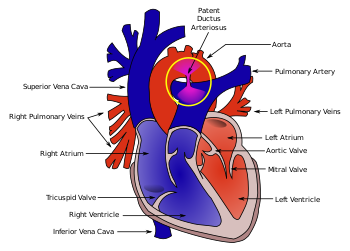
Back قناة شريانية مفتوحة Arabic Ductus arteriós persistent Catalan Otevřená Botallova dučej Czech Persistierender Ductus arteriosus German Ductus arterioso persistente Spanish Avatud arterioosjuha Estonian مجرای شریانی باز Persian Persistance du canal artériel French צינור עורקי פתוח HE Patent ductus arteriosus ID
| Patent ductus arteriosus | |
|---|---|
| Other names | Persistent ductus arteriosus |
 | |
| Diagram of a cross-section through a heart with PDA | |
| Specialty | Cardiac surgery, paediatrics |
| Symptoms | Shortness of breath, failure to thrive, tachycardia, heart murmur |
| Complications | Heart failure, Eisenmenger's syndrome, pulmonary hypertension |
| Causes | Idiopathic |
| Risk factors | Preterm birth, congenital rubella syndrome, chromosomal abnormalities, genetic conditions |
| Diagnostic method | Echocardiography, Doppler, X-ray |
| Prevention | Screening at birth, high index of suspicion in neonates at risk |
| Treatment | Nonsteroidal anti-inflammatory drugs (NSAIDs), surgery |
Patent ductus arteriosus (PDA) is a medical condition in which the ductus arteriosus fails to close after birth: this allows a portion of oxygenated blood from the left heart to flow back to the lungs through the aorta, which has a higher blood pressure, to the pulmonary artery, which has a lower blood pressure. Symptoms are uncommon at birth and shortly thereafter, but later in the first year of life there is often the onset of an increased work of breathing and failure to gain weight at a normal rate. With time, an uncorrected PDA usually leads to pulmonary hypertension followed by right-sided heart failure.
The ductus arteriosus is a fetal blood vessel that normally closes soon after birth. This closure is caused by vessel constriction immediately after birth as circulation changes occur, followed by the occlusion of the vessel’s lumen in the following days.[1] In a PDA, the vessel does not close, but remains patent (open), resulting in an abnormal transmission of blood from the aorta to the pulmonary artery. PDA is common in newborns with persistent respiratory problems such as hypoxia, and has a high occurrence in premature newborns. Premature newborns are more likely to be hypoxic and have PDA due to underdevelopment of the heart and lungs.
If the congenital defect transposition of the great vessels is present in addition to a PDA, the PDA is not surgically closed since it is the only way that oxygenated blood can mix with deoxygenated blood. In these cases, prostaglandins are used to keep the PDA open, and NSAIDs are not administered until surgical correction of the two defects is completed.
In full-term newborns, PDA occurs in 1 in 2,000 births, and accounts for 5–10% of congenital heart disease cases. PDA occurs in 20–60% of all premature newborns, where its incidence inversely linked with gestational age and weight.[2]
- ^ Clyman, Ronald I. (2017), "Mechanisms Regulating Closure of the Ductus Arteriosus", Fetal and Neonatal Physiology, Elsevier, pp. 592–599.e4, doi:10.1016/b978-0-323-35214-7.00057-3, ISBN 978-0-323-35214-7, retrieved 14 November 2023
- ^ Dice, JE; Bhatia, J (July 2007). "Patent ductus arteriosus: an overview". The Journal of Pediatric Pharmacology and Therapeutics. 12 (3): 138–46. doi:10.5863/1551-6776-12.3.138. PMC 3462096. PMID 23055849.